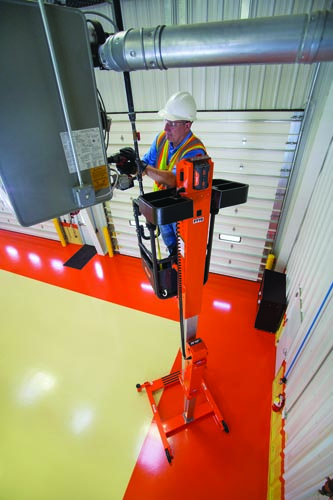Why are low-level access products gaining in popularity as a means of fall protection?

Low-level access products are gaining popularity over ladders for one main reason – safety. This category of lifts is a safer alternative to ladders, scaffolding and other forms of access. In addition, these machines enhance productivity, promote efficiency and provide environmental benefits that are increasingly of interest to operators and building owners.

Low-level access products are gaining popularity over ladders for one main reason – safety. This category of lifts is a safer alternative to ladders, scaffolding and other forms of access. In addition, these machines enhance productivity, promote efficiency and provide environmental benefits that are increasingly of interest to operators and building owners.
The use and popularity of low-level access lifts are growing for several reasons. One is that operators can use both hands comfortably to do work safely at height, 360 degrees around. This isn’t the case with ladders, where workers often must use one hand to stabilize themselves at height, leaving only one hand free to perform a task.
This equipment also features portability benefits. Low-level access equipment can be lowered and moved from one location to another, making it easy to perform multiple tasks throughout a facility in less time. In addition, some solutions can be operated with a cordless 18-volt drill, while others are powered by a 40-volt, lithium-ion battery that allows for smooth, cord-free operation.
Another benefit of low-level access lifts is that they can maneuver easily through standard doorways or standard double doorways. The personal portable lifts can be assembled and disassembled in minutes with two people and require little storage space when not in use. A benefit to being able to disassemble the lifts is that the pieces can be carried to previously inaccessible parts of a building. For example, if someone needs to complete work in an area accessible only by stairs, they can disassemble the lift, carry the pieces up or down the stairs, and then reassemble. Additionally, because the lifts are telescopic, they can fit into the back of a truck or van.
The non-powered realm of low-level access lifts includes models that feature a patented stored power lift system that requires no batteries, hydraulics, oil or controls. Because no hydraulics or motors are involved, these eco-friendly lifts are leak-free and operate quietly, making them a preferred piece of equipment for work in schools, hospitals and other institutions. In the interest of reduced environmental influence, these units also include non-marking wheels that minimize the impact on sensitive flooring.
It’s also important to note that low-level access helps with worker fatigue. With ladders, a worker must climb up and down to get the tools he or she needs. It can be exhausting work and can lead to an increased risk of falls or injuries. However, low-level access offers trays to rest tools on to get the work done quickly without a lot of moving up and down. If a worker needs to secure another tool, it’s as easy as moving a lift mechanism or pressing a button to ascend and descend.
Editor's note: This article represents the
independent views of the author and should not be construed as a
National Safety Council endorsement.

No comments:
Post a Comment